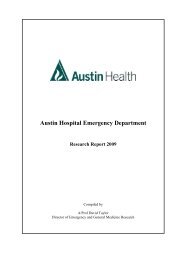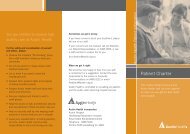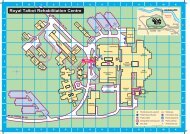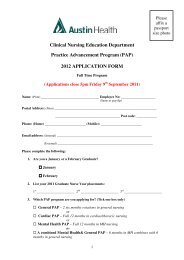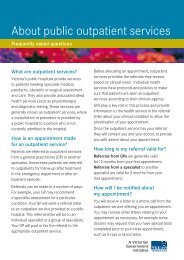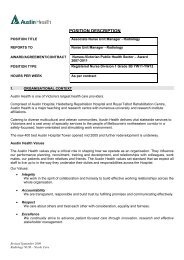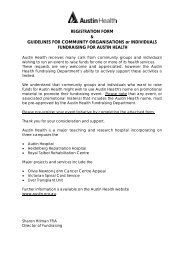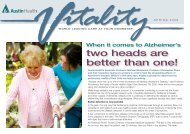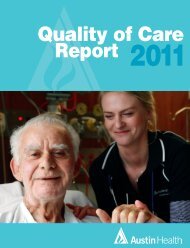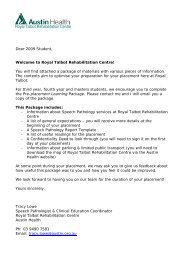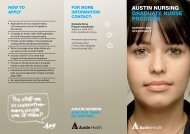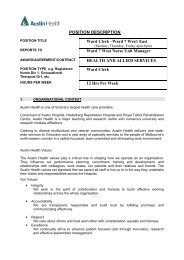Annual Report 2008-09 - Austin Health
Annual Report 2008-09 - Austin Health
Annual Report 2008-09 - Austin Health
You also want an ePaper? Increase the reach of your titles
YUMPU automatically turns print PDFs into web optimized ePapers that Google loves.
Pictured left: Mr Philip Hayward and<br />
Associate Prof George Matalanis perform an<br />
Australian-first form of aortic replacement<br />
surgery at <strong>Austin</strong> Hospital.<br />
February. Prof Pierce’s legacy includes<br />
the establishment of the Victorian<br />
Respiratory Support Service and Institute<br />
for Breathing and Sleep. An outstanding<br />
clinician, researcher and mentor, Prof<br />
Pierce was a passionate advocate for<br />
the respiratory and sleep health of<br />
indigenous Australians and had taken<br />
sabbatical leave in northern Australia to<br />
deepen his knowledge of these issues.<br />
In the days before his death, Prof Pierce<br />
received major funding from the Victorian<br />
Neurotrauma Initiative to research sleep<br />
disorders in quadriplegic patients. He will<br />
be sadly missed by all at <strong>Austin</strong> <strong>Health</strong>,<br />
but most acutely by his patients, research<br />
students and staff.<br />
SURGICAL<br />
Over 21,000 emergency and elective<br />
operations were performed during the<br />
year. This is an increase of more than<br />
3,200 operations, or 18 per cent, on 2007-<br />
08 and was accompanied by a 15 per<br />
cent increase in the number of patients<br />
added to the surgical waiting list. Despite<br />
this increase in demand, <strong>Austin</strong> <strong>Health</strong><br />
reduced its elective surgery waiting list<br />
by 783 patients, or 22 per cent, compared<br />
to the previous year. This was due to the<br />
opening of The Surgery Centre in July<br />
<strong>2008</strong>. Its four theatres, endoscopy room,<br />
and flexible cystoscopy room increased<br />
capacity for elective-only surgery.<br />
The Surgery Centre - breakdown of<br />
procedures performed<br />
<br />
<br />
<br />
<br />
<br />
<br />
With an innovative model focussed<br />
on less complex cases, over 5,000<br />
operations have been performed at<br />
The Surgery Centre since its opening.<br />
ANAESTHESIA AND PERIOPERATIVE<br />
Following a $2 million grant from<br />
DHS in November, the Operating Theatre<br />
Suite undertook major refurbishment<br />
works of two of its 12 theatres. Theatres<br />
three and four are used for complex<br />
procedures and were decommissioned<br />
for extensive upgrades. Comprehensive<br />
strategic planning ensured that the<br />
impact on work-flow was minimised.<br />
Works were completed in four months<br />
and met rigorous safety and quality<br />
standards before re-opening on 22 April.<br />
As patient throughput continues to<br />
increase year-on-year, innovative<br />
solutions are essential to maximise<br />
the use of resources and provide the<br />
best patient care. Elective surgery was<br />
quarantined at The Surgery Centre<br />
at Heidelberg Repatriation Hospital<br />
from the emergency surgery demands<br />
at <strong>Austin</strong> Hospital. Importantly, the<br />
relatively controlled environment of the<br />
centre offered valuable opportunities for<br />
clinical teaching.<br />
The implementation of green light<br />
laser treatment for enlarged prostates,<br />
or benign prostatic hyperplasia,<br />
commenced at The Surgery Centre in<br />
September following a Victorian Elective<br />
Surgery Funding grant of $179,000. The<br />
state-of-the-art technology replaced an<br />
invasive surgical procedure known as<br />
transurethral resection of the prostate<br />
(TURP). The green light laser therapy<br />
provides a minimally-invasive day<br />
procedure as effective as the traditional<br />
TURP, with fewer side effects. All of<br />
the theatre technicians, nursing staff<br />
and three urologists received extensive<br />
training on the use of the system and<br />
performed more than 60 treatments.<br />
INTENSIVE CARE UNIT<br />
The year was the busiest experienced by<br />
the Intensive Care Unit (ICU), which cared<br />
for over 2,000 critically ill patients. DHS<br />
provided funding to open an additional<br />
bed, bringing the number of funded<br />
beds to 17. At times of peak activity, ICU<br />
has expanded to full capacity within the<br />
20-bed area of pod A and pod B, and<br />
beyond into the adjacent 10 bed area<br />
of pod C for the first time. Additional<br />
funding was provided by DHS to purchase<br />
essential equipment including ventilators,<br />
haemofiltration machines, monitors<br />
and a video laryngoscope to enable the<br />
additional bed to be opened.<br />
The medical emergency team responded<br />
to over 1,800 calls. The ICU liaison nurse<br />
reviewed more than 1,600 patients,<br />
continued to provide follow-up services<br />
to patients discharged from ICU, and<br />
reviewed acutely unwell patients on<br />
the ward.<br />
The post-graduate critical care nursing<br />
program achieved excellent results this<br />
year. Several students were honoured<br />
in the top two per cent of all higher<br />
education students at RMIT for <strong>2008</strong>. This<br />
is testament to the graduates’ application,<br />
but also to the ICU educators and nursing<br />
staff in providing guidance, education and<br />
support throughout the year.<br />
CANCER SERVICES<br />
Cancer Services continued to work with<br />
the Olivia Newton-John Cancer and<br />
Wellness Centre (ONJCWC) project team<br />
on the design of the new centre. The<br />
ONJCWC will be constructed on the site<br />
of Cancer Services’ existing premises,<br />
Heidelberg House. In preparation for the<br />
demolition of the old building in 2010,<br />
Day Oncology moved into temporary<br />
accommodation in the nearby Lance<br />
Townsend Building. Old wards in the<br />
Harold Stokes Building were refurbished<br />
to meet current standards in preparation<br />
for receiving the cancer in-patient wards<br />
in August 20<strong>09</strong>.<br />
<br />
<br />
<br />
<br />
<br />
<br />
Planning for the ONJCWC programs<br />
continued. New positions will be<br />
created, including a manager’s position<br />
to develop the wellness and supportive<br />
care services. A grant was received from<br />
<br />
<strong>Austin</strong> <strong>Health</strong> : <strong>2008</strong>-<strong>09</strong> ANNUAL REPORT<br />
15



